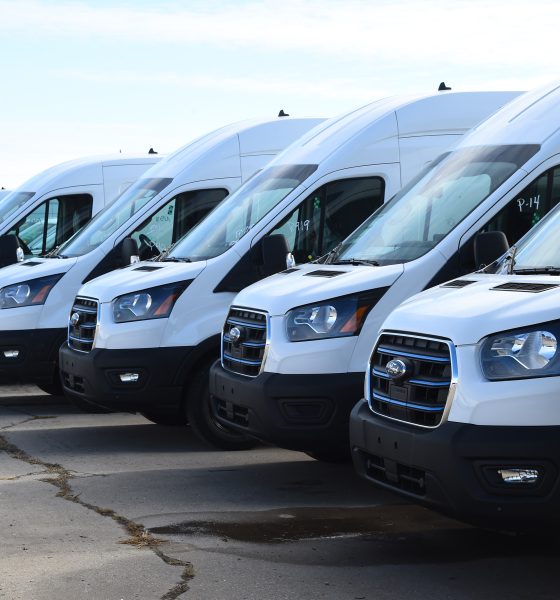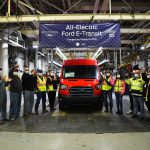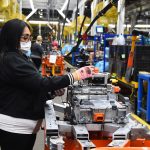

News
Ford begins shipping all-electric E-Transit, beginning fulfillment of over 10,000 units
Ford Motor Company announced today that it has successfully started shipping its brand new all-electric E-Transit van to customers, working to fulfill the over 10,000 orders the automaker has to for the vehicle.
“Ford E-Transit™, the electric version of America’s best-selling commercial van1 and the first of two all-electric vehicles purpose-built for Ford Pro™ commercial customers, is now shipping across the U.S. The popular E-Transit already has more than 10,000 orders from businesses of all sizes, and Ford is working on ways to increase production,” Ford wrote in a press release today.
The all-electric E-Transit is assembled at Ford’s Kansas City Assembly Plant, which is the automaker’s first plant to assemble batteries and all-electric vehicles in-house.
- The new E-Transit is produced at Kansas City Assembly Plant – Ford’s first U.S. plant to assemble both batteries and all-electric vehicles in-house Photo by Dave Kaup Dave Kaup Photography 913-219-3569 davekaup.photo@gmail.com www.davekaup.com
- The new E-Transit is produced at Kansas City Assembly Plant – Ford’s first U.S. plant to assemble both batteries and all-electric vehicles in-house Photo by Dave Kaup Dave Kaup Photography 913-219-3569 davekaup.photo@gmail.com www.davekaup.com
- The new E-Transit is produced at Kansas City Assembly Plant – Ford’s first U.S. plant to assemble both batteries and all-electric vehicles in-house Photo by Dave Kaup Dave Kaup Photography 913-219-3569 davekaup.photo@gmail.com www.davekaup.com
Ford has received orders for the E-Transit all over the U.S. The company said that it has more than 300 customers who have placed orders for over 10,000 total units. Last week, Wal-Mart confirmed to Teslarati in a statement that it had ordered 1,100 E-Transit vans from Ford.
The E-Transit has been a staple vehicle for many businesses and companies since its introduction in 1965. “E-Transit is a testament to the fact that an electric commercial fleet is no longer a vision of tomorrow, but a productivity-boosting modern reality,” President of The Americas & International Markets Group for Ford, Kumar Galhotra, said.
Ford boasts over 167 percent growth in EV sales, announces Wal-Mart’s 1,100 E-Transit order
Ford is using the moniker Ford Pro to launch forward its commercial and government accounts. Ford Pro is the company’s “global business and brand within Ford dedicated to delivering solutions to government and commercial customers of all sizes to help accelerate productivity, improve uptime, and lower operating costs through connected services and work-ready gas and electric vehicles,” the automaker wrote. Ford Pro is helping Ford get these vehicles to customers and businesses in America, driving them forward.
“Ford Pro is committed to driving businesses forward – from the Transit vans and F-150 trucks assembled right here in America by American workers2, to the many businesses it will help grow, to the communities that benefit from the jobs and revenue,” said GM of Ford Pro North America Tim Baughman said.
The E-Transit is one of Ford’s most important projects in recent memory, mostly because of its placement as a keystone in the automaker’s electrified fleet, and it is a vehicle that fits the Ford Pro template. However, the E-Transit joins the F-150 Lightning and Mustang Mach-E as two cars highlighting Ford’s electrification transition. Ford recently indicated that it would boost production estimates for the Mustang Mach-E and F-150 Lightning, aiming to reach 600,000 deliveries in just 22 months. CEO Jim Farley believes Ford can be the first legacy automaker to scale EV production, and it has made the most progress thus far.
I’d love to hear from you! If you have any comments, concerns, or questions, please email me at joey@teslarati.com. You can also reach me on Twitter @KlenderJoey, or if you have news tips, you can email us at tips@teslarati.com.

Elon Musk
Elon Musk and Tesla AI Director share insights after empty driver seat Robotaxi rides
The executives’ unoccupied tests hint at the rapid progress of Tesla’s unsupervised Robotaxi efforts.

Tesla CEO Elon Musk and AI Director Ashok Elluswamy celebrated Christmas Eve by sharing personal experiences with Robotaxi vehicles that had no safety monitor or occupant in the driver’s seat. Musk described the system’s “perfect driving” around Austin, while Elluswamy posted video from the back seat, calling it “an amazing experience.”
The executives’ unoccupied tests hint at the rapid progress of Tesla’s unsupervised Robotaxi efforts.
Elon and Ashok’s firsthand Robotaxi insights
Prior to Musk and the Tesla AI Director’s posts, sightings of unmanned Teslas navigating public roads were widely shared on social media. One such vehicle was spotted in Austin, Texas, which Elon Musk acknowleged by stating that “Testing is underway with no occupants in the car.”
Based on his Christmas Eve post, Musk seemed to have tested an unmanned Tesla himself. “A Tesla with no safety monitor in the car and me sitting in the passenger seat took me all around Austin on Sunday with perfect driving,” Musk wrote in his post.
Elluswamy responded with a 2-minute video showing himself in the rear of an unmanned Tesla. The video featured the vehicle’s empty front seats, as well as its smooth handling through real-world traffic. He captioned his video with the words, “It’s an amazing experience!”
Towards Unsupervised operations
During an xAI Hackathon earlier this month, Elon Musk mentioned that Tesla owed be removing Safety Monitors from its Robotaxis in Austin in just three weeks. “Unsupervised is pretty much solved at this point. So there will be Tesla Robotaxis operating in Austin with no one in them. Not even anyone in the passenger seat in about three weeks,” he said. Musk echoed similar estimates at the 2025 Annual Shareholder Meeting and the Q3 2025 earnings call.
Considering the insights that were posted Musk and Elluswamy, it does appear that Tesla is working hard towards operating its Robotaxis with no safety monitors. This is quite impressive considering that the service was launched just earlier this year.
Elon Musk
Starlink passes 9 million active customers just weeks after hitting 8 million
The milestone highlights the accelerating growth of Starlink, which has now been adding over 20,000 new users per day.

SpaceX’s Starlink satellite internet service has continued its rapid global expansion, surpassing 9 million active customers just weeks after crossing the 8 million mark.
The milestone highlights the accelerating growth of Starlink, which has now been adding over 20,000 new users per day.
9 million customers
In a post on X, SpaceX stated that Starlink now serves over 9 million active users across 155 countries, territories, and markets. The company reached 8 million customers in early November, meaning it added roughly 1 million subscribers in under seven weeks, or about 21,275 new users on average per day.
“Starlink is connecting more than 9M active customers with high-speed internet across 155 countries, territories, and many other markets,” Starlink wrote in a post on its official X account. SpaceX President Gwynne Shotwell also celebrated the milestone on X. “A huge thank you to all of our customers and congrats to the Starlink team for such an incredible product,” she wrote.
That growth rate reflects both rising demand for broadband in underserved regions and Starlink’s expanding satellite constellation, which now includes more than 9,000 low-Earth-orbit satellites designed to deliver high-speed, low-latency internet worldwide.
Starlink’s momentum
Starlink’s momentum has been building up. SpaceX reported 4.6 million Starlink customers in December 2024, followed by 7 million by August 2025, and 8 million customers in November. Independent data also suggests Starlink usage is rising sharply, with Cloudflare reporting that global web traffic from Starlink users more than doubled in 2025, as noted in an Insider report.
Starlink’s momentum is increasingly tied to SpaceX’s broader financial outlook. Elon Musk has said the satellite network is “by far” the company’s largest revenue driver, and reports suggest SpaceX may be positioning itself for an initial public offering as soon as next year, with valuations estimated as high as $1.5 trillion. Musk has also suggested in the past that Starlink could have its own IPO in the future.
News
NVIDIA Director of Robotics: Tesla FSD v14 is the first AI to pass the “Physical Turing Test”
After testing FSD v14, Fan stated that his experience with FSD felt magical at first, but it soon started to feel like a routine.

NVIDIA Director of Robotics Jim Fan has praised Tesla’s Full Self-Driving (Supervised) v14 as the first AI to pass what he described as a “Physical Turing Test.”
After testing FSD v14, Fan stated that his experience with FSD felt magical at first, but it soon started to feel like a routine. And just like smartphones today, removing it now would “actively hurt.”
Jim Fan’s hands-on FSD v14 impressions
Fan, a leading researcher in embodied AI who is currently solving Physical AI at NVIDIA and spearheading the company’s Project GR00T initiative, noted that he actually was late to the Tesla game. He was, however, one of the first to try out FSD v14.
“I was very late to own a Tesla but among the earliest to try out FSD v14. It’s perhaps the first time I experience an AI that passes the Physical Turing Test: after a long day at work, you press a button, lay back, and couldn’t tell if a neural net or a human drove you home,” Fan wrote in a post on X.
Fan added: “Despite knowing exactly how robot learning works, I still find it magical watching the steering wheel turn by itself. First it feels surreal, next it becomes routine. Then, like the smartphone, taking it away actively hurts. This is how humanity gets rewired and glued to god-like technologies.”
The Physical Turing Test
The original Turing Test was conceived by Alan Turing in 1950, and it was aimed at determining if a machine could exhibit behavior that is equivalent to or indistinguishable from a human. By focusing on text-based conversations, the original Turing Test set a high bar for natural language processing and machine learning.
This test has been passed by today’s large language models. However, the capability to converse in a humanlike manner is a completely different challenge from performing real-world problem-solving or physical interactions. Thus, Fan introduced the Physical Turing Test, which challenges AI systems to demonstrate intelligence through physical actions.
Based on Fan’s comments, Tesla has demonstrated these intelligent physical actions with FSD v14. Elon Musk agreed with the NVIDIA executive, stating in a post on X that with FSD v14, “you can sense the sentience maturing.” Musk also praised Tesla AI, calling it the best “real-world AI” today.











